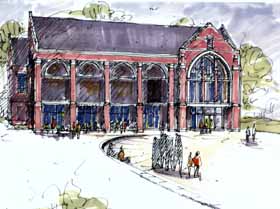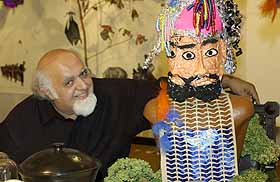|
This is an archived article.
For the latest news, go to the Advance
Homepage
For more archives, go to the Advance Archive/Search Page. |
||||
|
Benton
Programming Ties Arts
To Academic Programs, Community By Sherry Fisher
They asked him if they were at the Benton Museum. "'Yes, you are,' I said," Scalora recalls. "Thank goodness," the ladies said. "We've just come all the way from New York to see the show." The women had driven to Storrs to see The Mystical Arts of Tibet: Featuring the Personal Sacred Objects of the Dalai Lama, an exhibit that drew some 16,000 people to the museum during an eight-week period. It was an all-time attendance record for the Benton, which usually has about 20,000 patrons a year.
"It was amazing," Scalora says. "It inspired people from all walks of life." The Mystical Arts of Tibet featured more than 30 special public programs and the creation of two sacred sand mandalas by resident Buddhist monks. Fourteen campus centers and departments joined the Benton on the project. That's just the kind of programming Scalora envisioned when he took the reins at the Benton five years ago: expanded community involvement and international diversity. "We want to be relevant," says Scalora, whose commitment to human rights has been reflected in much of the Benton's programming. "We want the museum to be an integral part of the University. We want to partner with departments and centers at UConn. Many of our exhibits have high educational components." Soon, a new 7,000-square foot, two-story addition will expand the Benton's exhibit space and boost its presence on campus. Scalora says some of the added space will be used to display more of the Benton's permanent collection, which includes some 5,000 works of art dating from the past 500 years. The firm of Arbonies King Vlock Architects of Branford designed the $3.2 million project. The addition, called the The Evelyn Simon Gilman Gallery, will face the Student Union quadrangle. "The additional space will allow the Benton to display aspects of our permanent collection on a more regular basis," Scalora says. "At times it will provide badly needed space in which to display large traveling shows such as the massive 220 piece Gordon Parks retrospective coming to us in the fall of 2003 from the Corcoran Gallery in Washington, D.C." The new wing was made possible by an $800,000 gift from Evelyn S. Gilman '47 of West Hartford. The groundbreaking took place Saturday, September 28. The addition will be completed in November 2003. David Woods, dean of the School of Fine Arts, says the new addition will expand the opportunities for students and faculty in the arts. "It will certainly be a center for the cultural arts on campus, but more that that, it will be an extension of our human rights program," Woods says. The addition is part of a three-phase project. The second phase is the building of a human rights gallery, exclusively dedicated to presenting human rights-oriented visual art exhibitions. "These would play a complementary role connecting the work of the Dodd Center and other parts of the University and the museum," Scalora says. "We'll be the visual component. Just as the library holds books, we hope to acquire and display a fascinating collection of artworks that will visually explore human rights history in the U.S. and throughout the world." The third part of the project is the creation of a human rights meditation sculpture garden, which Scalora says "will be a beautiful, peaceful space for meditation and healing." The Benton has been involved in exhibits related to human rights for several years. Last year, for example, Chancellor John Petersen designated the fall as Human Rights Semester, with events and activities underscoring the importance of human rights. The Benton's programming reflected that with an exhibit on rescuers of the Holocaust, portraits from Cambodia's killing fields, self-portraits of a Holocaust artist and 55 life-size figurative sculptures that explored other human rights issues. Faculty and students used the exhibit in their courses, and busloads of school children came from around the state, Scalora says. It was a perfect example of the way in which visual art can add significantly to academic and cultural life, while serving the greater community. |
 ne morning last spring Salvatore Scalora heard a knock on
the museum's door. "I opened it and there stood three
elderly ladies," says Scalora, director of the William Benton
Museum of Art.
ne morning last spring Salvatore Scalora heard a knock on
the museum's door. "I opened it and there stood three
elderly ladies," says Scalora, director of the William Benton
Museum of Art.

